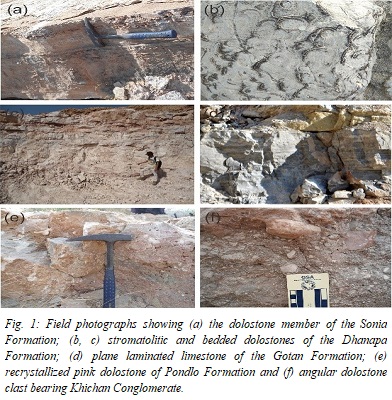 The Ediacaran-Cambrian transition period was one of the most significant intervals in the Earth’s history. Widespread changes in the oceanic and atmospheric conditions characterized this interval, which likely triggered the radiation of metazoans. Much of our knowledge of these changes have come from geochemical studies of marine carbonates deposited during this time. In search of such information and to establish the true geographical extent of these events, we carried out a detailed field and geochemical investigation in the Bilara Group of the Marwar Supergroup, the youngest Proterozoic marine carbonate succession of peninsular India. The variations in the 87Sr/86Sr observed in the limestone formation of the Bilara Group (0.70810 to 0.70916) suggest an early Cambrian (520–539 Ma) depositional age for the Group. We identify two δ13C negative excursions of magnitudes ~6‰ and ~7‰, respectively, in the middle and lower parts of the Bilara Group. Since these δ13C anomalies are observed through-out the Marwar Basin that was connected to global oceans, we believe that they represent temporal changes in the chemistry of seawater. Using the principles of δ13C stratigraphy and the available geochronological information, we correlate the middle Bilara anomaly to the Shiyantou carbon isotope excursion (SHICE). Although, poor age constraints hinder a definitive correlation of the older Bilara anomaly, we speculate that it is the basal Cambrian carbon isotope excursion (BACE). These results place the Ediacaran-Cambrian boundary closer to the basal part of the Bilara Group in the Marwar Supergroup.
The Ediacaran-Cambrian transition period was one of the most significant intervals in the Earth’s history. Widespread changes in the oceanic and atmospheric conditions characterized this interval, which likely triggered the radiation of metazoans. Much of our knowledge of these changes have come from geochemical studies of marine carbonates deposited during this time. In search of such information and to establish the true geographical extent of these events, we carried out a detailed field and geochemical investigation in the Bilara Group of the Marwar Supergroup, the youngest Proterozoic marine carbonate succession of peninsular India. The variations in the 87Sr/86Sr observed in the limestone formation of the Bilara Group (0.70810 to 0.70916) suggest an early Cambrian (520–539 Ma) depositional age for the Group. We identify two δ13C negative excursions of magnitudes ~6‰ and ~7‰, respectively, in the middle and lower parts of the Bilara Group. Since these δ13C anomalies are observed through-out the Marwar Basin that was connected to global oceans, we believe that they represent temporal changes in the chemistry of seawater. Using the principles of δ13C stratigraphy and the available geochronological information, we correlate the middle Bilara anomaly to the Shiyantou carbon isotope excursion (SHICE). Although, poor age constraints hinder a definitive correlation of the older Bilara anomaly, we speculate that it is the basal Cambrian carbon isotope excursion (BACE). These results place the Ediacaran-Cambrian boundary closer to the basal part of the Bilara Group in the Marwar Supergroup.
Bibliographic Info: Bivin G. George, Sanjeev Kumar, Jyotiranjan S. Ray [2021]. C-Sr isotope stratigraphy of carbonate formations of the late Neoproterozoic - Cambrian Marwar supergroup, western India. Precambrian Research, Vol. 364, Art. 106378. https://doi.org/10.1016/j.precamres.2021.106378




 सूचना का अधिकार
सूचना का अधिकार